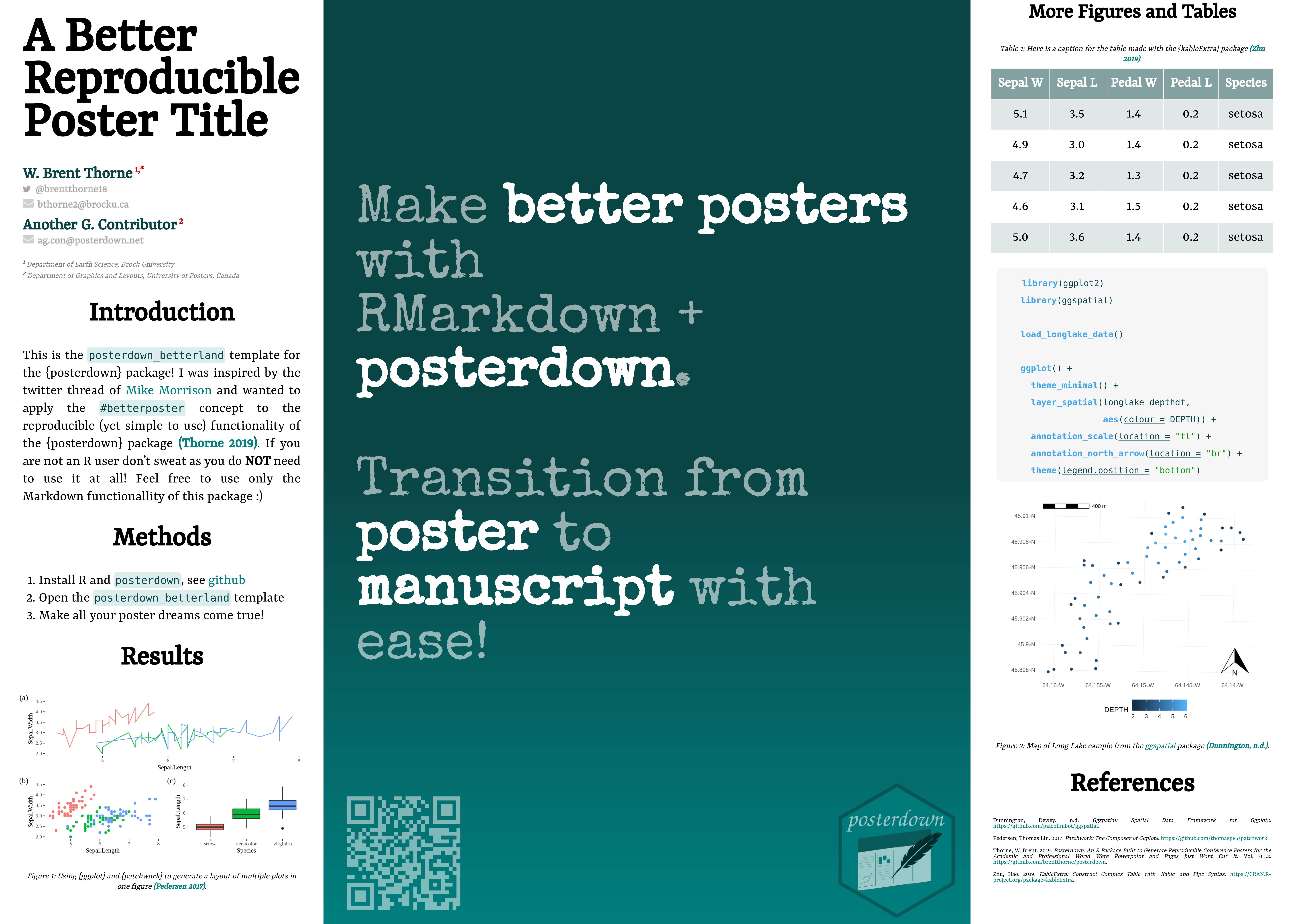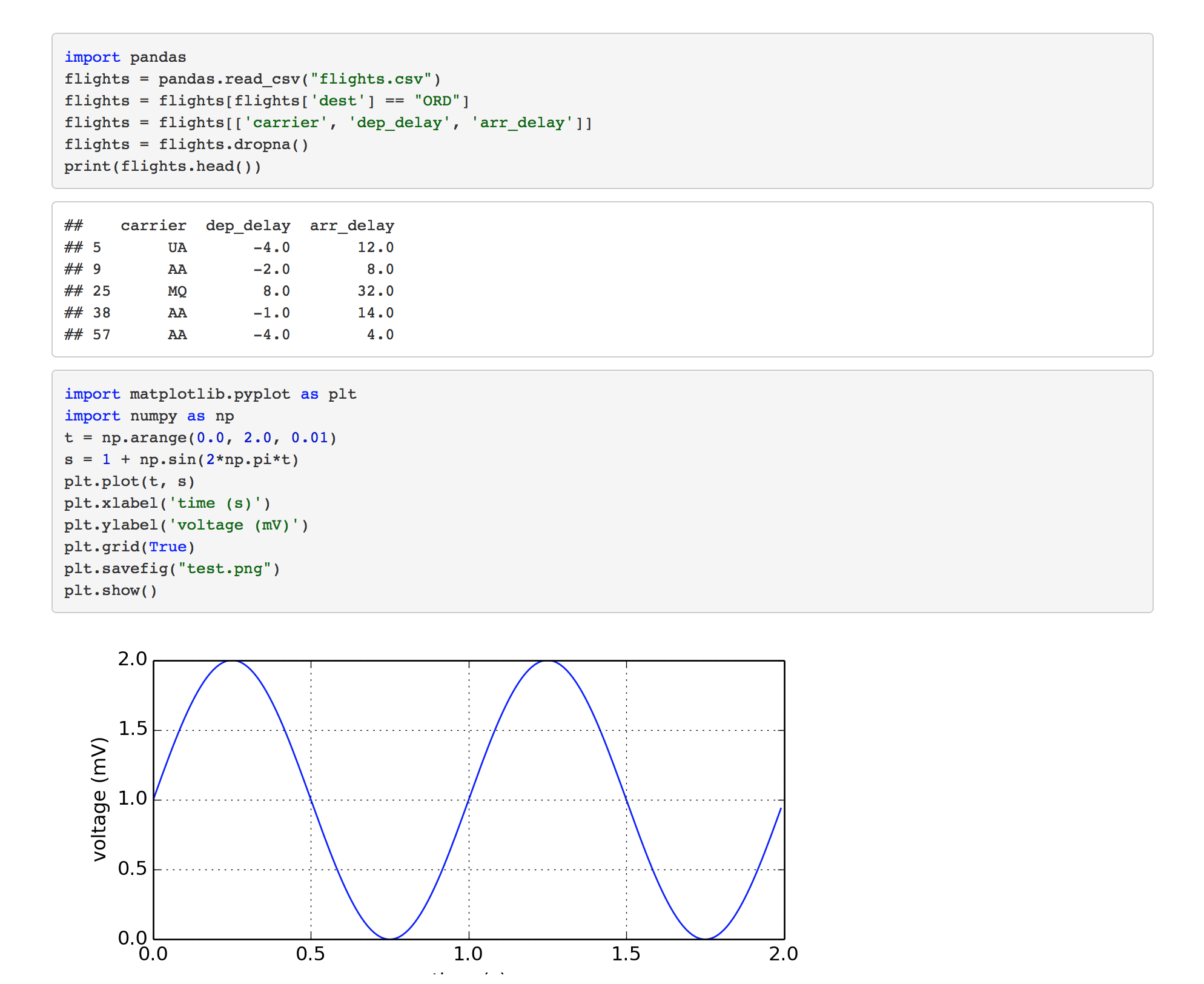Using Python with RStudio#. You can use Python with RStudio professional products to develop and publish interactive applications with Shiny, Dash, Streamlit, or Bokeh; reports with R Markdown or Jupyter Notebooks; and REST APIs with Plumber or Flask. Chapter 51 Python in Rmarkdown. This is a quick tutorial for running Python code in an R Markdown file. This is especially useful for final projects where students may want to use Python for data cleaning, string manipulation, and even machine learning. Feb 20, 2019 Using Python in RMarkdown In order to write blog posts using Python code, I wanted to figure out a way to include Python code chunks in RMarkdowns. When you insert a code chunk in RMarkdown, you have the option of specifying the language of that chunk: the default is R, but you can also insert a Bash, SQL, Python, etc. Now, more and more people are using Rmarkdown and Rstudio to work together in R and Python. I reckon the need to have an improvement for rmarkdown that it can support text highlighting for Python code. See an example below: By filing an.
Using Python in RMarkdown
In order to write blog posts using Python code, I wanted to figure out a way to include Python code chunks in RMarkdowns. When you insert a code chunk in RMarkdown, you have the option of specifying the language of that chunk: the default is R, but you can also insert a Bash, SQL, Python, etc. code chunk.
When I attempted to insert a Python code chunk and import libraries, however, I kept getting the error:
Error in py_run_string_impl(code, local, convert) :ImportError: No module named sklearn.cluster
From running Python in Atom, I knew I had the sklearn.cluster module installed, so the problem must be in the connection between R and Python.
reticulate
The reticulate package in R (website here allows R to interact with Python. I installed the package from RStudio.
Changing Python versions
Installing reticulate still didn’t allow me to knit the RMarkdown with a Python code chunk, however. I followed the instructions in this post by Pablo Franco to check the Python version that reticulate was using:
I ended up with the following output:
I wanted to be running Python version 3.6, which was the version I had installed using Anaconda, so I needed to change the path.
Set-up chunk
I discovered that you can set the path to a different installation of Python by modifying the setup chunk at the start of the RMarkdown. According to the bookdown website, the default used is Python 2.
My default version of this set-up chunk looks like this:
You can set the chunk option engine.path to specify the path to the engine interpreter and change it from the default Python 2.
Finding Python path
I now needed to find the actual path to Python that I wanted to use. I did this by opening up Python separately from RStudio (I used Atom for this) and running the following (I got the code for this from here):
From this information, I could tell I wanted to use the path /anaconda3/lib/python3.6, rather than /usr/bin/python, which is what RMarkdown had originally been using. I modified by set-up chunk to look like this:
Other options

This solution enabled me to knit RMarkdowns with Python code chunks! It changes the engine interpreter globally, which you could do for multiple engines simultaneously, like Python and Ruby, for example:
Alternatively, you can specify the engine interpreter locally in each code chunk by starting the chunk with {python, engine.path = '/anaconda3/bin/python3.6}, for example.
Related
We are pleased to announce the reticulate package, a comprehensive set of tools for interoperability between Python and R. The package includes facilities for:
Calling Python from R in a variety of ways including R Markdown, sourcing Python scripts, importing Python modules, and using Python interactively within an R session.
Translation between R and Python objects (for example, between R and Pandas data frames, or between R matrices and NumPy arrays).
Flexible binding to different versions of Python including virtual environments and Conda environments.
Reticulate embeds a Python session within your R session, enabling seamless, high-performance interoperability. If you are an R developer that uses Python for some of your work or a member of data science team that uses both languages, reticulate can dramatically streamline your workflow!
You can install the reticulate pacakge from CRAN as follows:
Read on to learn more about the features of reticulate, or see the reticulate website for detailed documentation on using the package.
Python in R Markdown
The reticulate package includes a Python engine for R Markdown with the following features:
Run Python chunks in a single Python session embedded within your R session (shared variables/state between Python chunks)
Printing of Python output, including graphical output from matplotlib.
Access to objects created within Python chunks from R using the
pyobject (e.g.py$xwould access anxvariable created within Python from R).Access to objects created within R chunks from Python using the
robject (e.g.r.xwould access toxvariable created within R from Python)
Built in conversion for many Python object types is provided, including NumPy arrays and Pandas data frames. From example, you can use Pandas to read and manipulate data then easily plot the Pandas data frame using ggplot2:
Note that the reticulate Python engine is enabled by default within R Markdown whenever reticulate is installed.
See the R Markdown Python Engine documentation for additional details.
Importing Python modules
You can use the import() function to import any Python module and call it from R. For example, this code imports the Python os module and calls the listdir() function:
Functions and other data within Python modules and classes can be accessed via the $ operator (analogous to the way you would interact with an R list, environment, or reference class).
Imported Python modules support code completion and inline help:
See Calling Python from R for additional details on interacting with Python objects from within R.
Sourcing Python scripts
You can source any Python script just as you would source an R script using the source_python() function. For example, if you had the following Python script flights.py:
Then you can source the script and call the read_flights() function as follows:
See the source_python() documentation for additional details on sourcing Python code.
Python REPL
If you want to work with Python interactively you can call the repl_python() function, which provides a Python REPL embedded within your R session. Objects created within the Python REPL can be accessed from R using the py object exported from reticulate. For example:
Enter exit within the Python REPL to return to the R prompt.
Note that Python code can also access objects from within the R session using the r object (e.g. r.flights). See the repl_python() documentation for additional details on using the embedded Python REPL.
R Markdown Tutorial
Type conversions
When calling into Python, R data types are automatically converted to their equivalent Python types. When values are returned from Python to R they are converted back to R types. Types are converted as follows:
| R | Python | Examples |
|---|---|---|
| Single-element vector | Scalar | 1, 1L, TRUE, 'foo' |
| Multi-element vector | List | c(1.0, 2.0, 3.0), c(1L, 2L, 3L) |
| List of multiple types | Tuple | list(1L, TRUE, 'foo') |
| Named list | Dict | list(a = 1L, b = 2.0), dict(x = x_data) |
| Matrix/Array | NumPy ndarray | matrix(c(1,2,3,4), nrow = 2, ncol = 2) |
| Data Frame | Pandas DataFrame | data.frame(x = c(1,2,3), y = c('a', 'b', 'c')) |
| Function | Python function | function(x) x + 1 |
| NULL, TRUE, FALSE | None, True, False | NULL, TRUE, FALSE |
If a Python object of a custom class is returned then an R reference to that object is returned. You can call methods and access properties of the object just as if it was an instance of an R reference class.
Learning more
The reticulate website includes comprehensive documentation on using the package, including the following articles that cover various aspects of using reticulate:
Calling Python from R — Describes the various ways to access Python objects from R as well as functions available for more advanced interactions and conversion behavior.
R Markdown Python Engine — Provides details on using Python chunks within R Markdown documents, including how call Python code from R chunks and vice-versa.
Python Version Configuration — Describes facilities for determining which version of Python is used by reticulate within an R session.
Installing Python Packages — Documentation on installing Python packages from PyPI or Conda, and managing package installations using virtualenvs and Conda environments.
Using reticulate in an R Package — Guidelines and best practices for using reticulate in an R package.
Arrays in R and Python — Advanced discussion of the differences between arrays in R and Python and the implications for conversion and interoperability.
Why reticulate?
From the Wikipedia article on the reticulated python:
The reticulated python is a speicies of python found in Southeast Asia. They are the world’s longest snakes and longest reptiles…The specific name, reticulatus, is Latin meaning “net-like”, or reticulated, and is a reference to the complex colour pattern.
Tables In Rmarkdown
From the Merriam-Webster definition of reticulate:
1: resembling a net or network; especially : having veins, fibers, or lines crossing a reticulate leaf. 2: being or involving evolutionary change dependent on genetic recombination involving diverse interbreeding populations.

The package enables you to reticulate Python code into R, creating a new breed of project that weaves together the two languages.
Python In Markdown Cell
UPDATE:Nov. 27, 2019
Learn more about how R and Python work together in RStudio.
